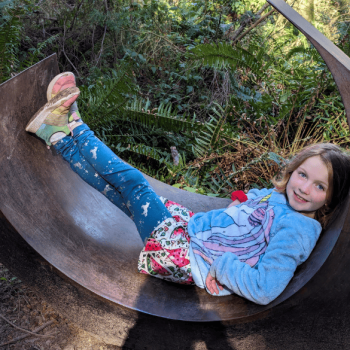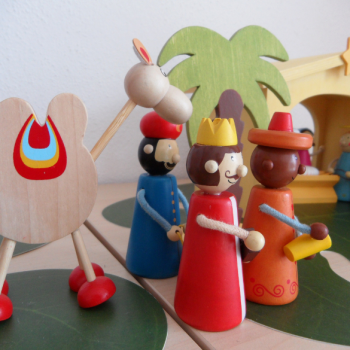
If you can read picture books and keep your kids engaged, you can do the same thing with Bible stories. Far too often parents give their all to read picture books, but then leave that same enthusiasm and effort behind when they read Bible stories for kids.
(This may contain some affiliate links, which means I receive a small commission, at no extra cost to you, if you make a purchase using these links. For more information, please see my disclosure policy.)
Series Helping Your Kids Own Their Faith
This is week 4 of a series on equipping you to help your child to own their faith. We have already talked about:
Let’s talk about how to help your kids own their faith with Bible stories.
Picture Books Vs. Bible Stories for Kids
Picture books are wonderful and I highly encourage reading A LOT with your kids. These books are fun and easy to read because they have engaging dialogue with punctuation and fonts to direct you, the reader, how to read them well.
Bible stories, even in most children’s storybook Bibles, do not have that kind of direction in the text. This means it takes a little more effort to read the Bible stories for kids to keep them engaged. But, you can do it!
Let’s compare and contrast picture books and Bible stories for kids and their benefits.
(For a full list, check out createdtoplay.com/freeresources.)
Truth
- Picture books may or may not be true stories.
- Bible stories are true stories.
Preparation
- Picture books may help get kids ready for school.
- Bible stories get kids ready for eternity.
Author
- More often than not, you do not personally know the author of picture books.
- The author of Bible stories created and personally knows your child with the desire for your child to personally know him, too.
Connection
- Picture books are great for bonding and connecting with your child.
- Bible stories for kids connect you with your child, your child with God, and you with God.
Three Easy Skills for Making Bible Stories for Children Engaging
When I serve in the toddler class at church I always bring one of my favorite children’s storybook Bibles to read from. More often than not, after our first story, which matches whatever the rest of the classes are reading, the kids will ask me to read another story. They don’t do this with all of the teachers, but they consistently do it with me.
There is nothing special about me, but there is something special about the way I read Bible stories for children because there is something special about the Bible. I want kids to see that, feel that, experience that for themselves.
I also use these strategies at home and you can, too!
Movements
Kids are wiggly and God designed them that way. Young kids learn first through their bodies. In A Moving Child is a Learning Child authors, Gill Connell and Cheryl McCarthy, write, “The more a child moves, the more a child knows. The more a child knows, the more a child wants to know, the more a child wants to know, the more a child moves.”
If movement is the way kids learn and express their desire to learn, should we be asking them to sit still while reading Bible stories together?
The above book goes one to share that young children’s brains prioritize thinking tasks and can only do one at a time. Listening well is a thinking task and so is sitting still. If they can only do one thinking task at a time, which would you prefer them to do?
Personally, I want them to listen. So, that means I need to let them move!
We can incorporate intentional movement into our stories by having kids act out simple movements that go with the stories. For example:
- Walking on water
- Rocking in a boat during a storm
- Wiping your forehead when it is hot
- Offering a gift with your arms out in front of you
- Swinging a slingshot
iMagination
By activating our children’s imaginations during Bible stories we are helping the story come to life. We are bringing the child into the story in a way that our words alone cannot do.
But, to help our children imagine stories from the Bible, they must be able to visualize them. Our kids need more context than we typically give them.
They need to know what did the setting look like? What did the people look like? What did the clothes look like?
My daughters love this book series to help them to understand more of the culture: Bible Infographics.
Some simple illustrations and conversations can help your child to begin to use their imagination and help the Bible stories come to life.
Tip: Though I don’t discard illustrations with blondes, I do try to help my children know a more accurate understanding of what the people may have looked like.
eMotions
One of the best things to help our kids imagine is how the characters in the Bible stories were feeling! This helps our kids to grow their emotional intelligence and to connect with the characters in a really impactful way.
Recognizing and identifying the emotions of the characters in the Bible stories helps the stories and people to become relevant and relatable to our children. This brings the story to life in a meaningful way.
Then we can talk about if they responded to their emotions in a way that was loving to God and others or not.
We shouldn’t label the emotions as good or bad because that can cause shame and feelings of being unsafe to share their own feelings, but we can talk about how to lovingly respond to our feelings using the characters in the Bible stories.
Also, by adding in the imagination aspect to the emotions we create another power advantage. When children pretend or imagine emotions, they feel them for real. So, if we help our kids to identify the fear of the disciples on the boat in the storm and then their peace and awe that Jesus calmed the storm, our children have then experienced the peace of Jesus. We can help them connect that to other times in their own lives that Jesus can bring peace or how to take their fear to God.
Bible Stories for Kids to Own Their Faith
When we use these three simple strategies to tell Bible stories to children, whether we are using a storybook Bible or a full-text Bible, our kids become engaged and experience the stories for themselves. The stories are real, relatable, and relevant. Our child will fall in love with the experience of reading the Bible and know that in his presence “is abundant joy.” Psalm 16:11 CSB
Kids who love the Bible will begin to own that joy and find comfort in God’s Word. We have to start by modeling that love by giving our best effort and energy to reading it to our kids. If we think it is boring, we make it boring.














